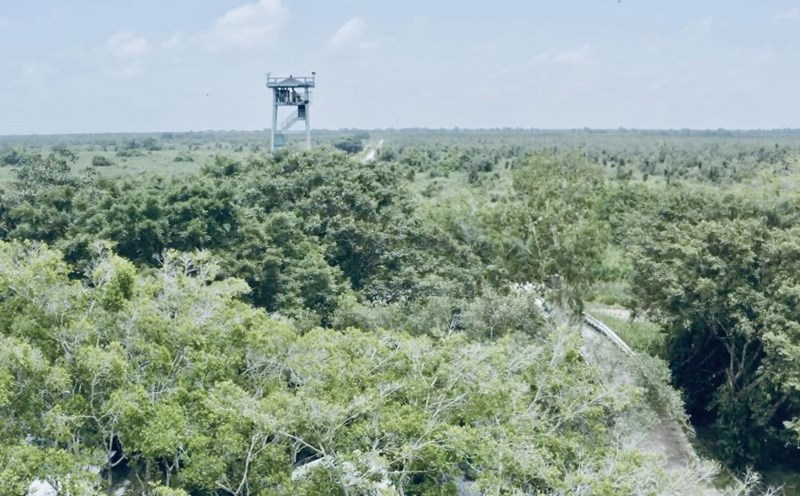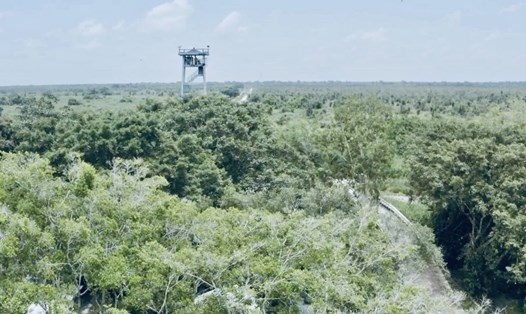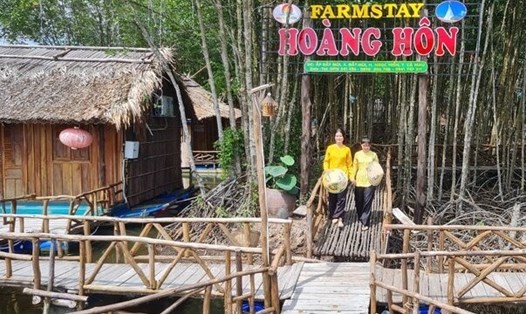Indeed, after stepping down the motorized, small and long boat like a floating grain, washing away the water hyacinth, I was shocked to see the water color of the canal. A scary black color has appeared, leading to uncomfortable associations.
Therefore, when the boat started to speed up the wind-pulling under the control of the experienced and familiar garden staff, I sat cramped, reducing my body fat to the point of being afraid of panic: Avoid being hit by the scary water or unfortunately falling into this canal, not knowing how many times I have to bathe to get rid of the smell.
But strangely, after driving a short distance, I found that this black water had no smell like the illusion of oppression, the space only had the smell of water hyacinth and occasionally the smell of cajuput flowers. And the water released from both sides of the profanel shell is not black but is brown like coffee or red like distilled bone broth.
Seeing my tense face, Mr. Vo Thanh Dung, a specialist of the Department of Ecotourism & Environmental Education of U Minh Ha National Park, asked: "The Ministry is still afraid of repelling mosquito bites? Don't worry, luckily it's sunny today so some things are gone, but if it rains, we can get together right away."
When I was able to share about the scary water,ung cuoi as if meeting a countryside man, no, it must be going into the forest. Just put your hand in the water, steep a piece of water and then bring it up to show me. Oh my, why didn't it get a black one at all, but it turned out to be the right coffee latte color.
Under Duong's explanation, I was moved to return to the miraculous water that has made the identity of this U Minh forest. Unlike the water in any place, which is white, green (due to algae), coban green (due to minerals), black (due to pollution), the water in U Minh Ha National Park has a spectrum of colors from light brown to red. That strange color of water is caused by the cajuput tree.
With the cajuput forest ecosystem on muddy coal (desecuted by cajuput under the condition of being defused by gas), about 2,593.7 hectares wide, it can be said that here, when you look up and see cajuput leaves, when you bend down, you can also see cajuput leaves submerged in water. During the leaf- fallen seasons, millions of cajuput leaves fall into the water and accumulate at the bottom of the meander, then the shea mixture dissolves and blends into the water.
As for the leaves that fell on the forest land, when it rained, the cajuput leaves decomposed, seeping through the layer of mud and dissolving into water, creating a characteristic red color. The reason, at first glance, the black water depends on the layer of mud and vegetation at the bottom of the canal, light and weather, the rest is a red-brown water.
No wonder, people living in U Minh forest have an ancient saying that describes this black water: "U Minh water is still faithfully red, like the heroic blood dyed red with the homeland". This phenomenon of red water is only present in U Minh Thuong (formerly Kien Giang, now An Giang) and U Minh Ha because they both have cadmium geology and the cajuput forest ecosystem.
Wherever there is mud, there is red water, the thicker the mud coal layer is, the darker the red water color. The thickness of red water also depends on rainfall, the dry season of deep red water, the rainy season of light red or light brown water. But regardless of the season, this is always a source of water that nourishes life in U Minh forest.
Chemical analysis shows that this red cajuput juice is rich in nutrients, especially protein, helping forests' animals and plants to thrive, especially freshwater fish and seafood, the source of ingredients to create delicious dishes that will be introduced in the following period.
This is also a valuable source of water for residents who lived in the former U Minh forest. They used to use this red-brown cauliflower water for daily consumption, laundry, and normal baths. It is not known whether that is why the main colors of the trio's houses are brown and black, so that they may not be affected by black tea.
In fact, " seeing it like that makes a gap" as the familiar saying of the Southern people goes. Because this red cauliflower water is clear and has an unexpected purity. Therefore, after listening to Mr. Dung's explanation, a younger brother in the group immediately reached up to drink some water to check and enjoy the delicious drink.
When everything the mystery is explained, the clam suddenly becomes much more interesting. The boat's shell gently drifted at low speed, the two canals were covered with blue buoys, revealing a completely contrasting red-brown water layer. We squeeze through the cajuput forests and enjoy the fresh, cool air.
My eyes were filled with the wild, quiet natural scenery, sometimes broken by a bird's sound or the take-off of a fence of a flock of birds, just like the folk song: "U Minh, strange land/ The fish are afraid, the fish in the region are also afraid".
But U Minh Ha also has a magical and poetic beauty with the calm red-brown water flowing under the green forest canopy. The cajuput leaves and cajuput trees have covered this land, and when they die, they continue to release living diseases into the water source to nourish all kinds of species.











